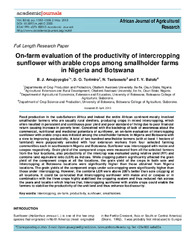| dc.contributor.author | Amujoyegbe, B.J. | |
| dc.contributor.author | Torimiro, D.O. | |
| dc.contributor.author | Tselaesele, N. | |
| dc.contributor.author | Balole, TV | |
| dc.date.accessioned | 2020-10-22T09:32:11Z | |
| dc.date.accessioned | 2021-03-15T09:37:50Z | |
| dc.date.available | 2020-10-22T09:32:11Z | |
| dc.date.available | 2021-03-15T09:37:50Z | |
| dc.date.issued | 2013-05-02 | |
| dc.identifier.citation | Amujoyegbe, B. J., Torimiro, D. O., Tselaesele, N., & Balole, T. V. (2013). On-farm evaluation of the productivity of intercropping sunflower with arable crops among smallholder farms in Nigeria and Botswana. African Journal of Agricultural Research, 8(16), 1553-1558. | en_US |
| dc.identifier.issn | 1991-637X | |
| dc.identifier.uri | https://academicjournals.org/journal/AJAR/article-abstract/AD0ADD135242 | |
| dc.identifier.uri | http://moodle.buan.ac.bw:80/handle/123456789/294 | |
| dc.description.abstract | Food production in the sub-Saharan Africa and indeed the entire African continent mostly involved smallholder farmers who are usually rural dwellers, producing crops in mixed intercropping, which often resulted in persistent and continuous poor yield and poor standard of living due to poor financial return causing increase in poverty level. Conceived with the backdrop of lack of awareness about the commercial, nutritional and medicinal potentials of sunflower, an on-farm evaluation of intercropping sunflower with arable crops was initiated among the smallholder farmers in Nigeria and Botswana with a view to improving productivity. A total of two hundred smallholder farmers (with at least 1 hectare of farmland) were purposively selected with four extension workers from four selected farming communities each in southwestern Nigeria and Botswana. Sunflower was intercropped with maize and cowpea respectively. Grain yield of the component crops were measured from all the selected farmers from the four locations, also productivity of the intercrop was evaluated using relative yield (RY) and combine land equivalent ratio (LER) as indices. While cropping pattern significantly affected the grain yield of the component crops at all the locations, the grain yield of the crops in both sole and intercropping at Botswana locations were significantly higher than those obtained from Nigeria locations. The grain yields of the component crops under sole cropping were significantly higher than those under intercropping. However, the combine LER were above 200% better than sole cropping at all locations. It could be concluded that intercropping sunflower with maize and or cowpea or in combination with the three crops highly stabilized the cropping system and thus reduced risk across the years and location which implies that, intercropping sunflower with arable crops could enable the farmers to stabilize the productivity of the unit land and thus enhance food security. | en_US |
| dc.language.iso | en | en_US |
| dc.publisher | Academic Journals | en_US |
| dc.relation.ispartofseries | African Journal of Agricultural Research;Vol. 8 (16) 2013 | |
| dc.subject | Intercropping | en_US |
| dc.subject | On-farm | en_US |
| dc.subject | Productivity | en_US |
| dc.subject | Sunflower | en_US |
| dc.subject | Smallholders | en_US |
| dc.title | On-farm evaluation of the productivity of intercropping sunflower with arable crops among smallholder farms in Nigeria and Botswana | en_US |
| dc.type | Article | en_US |

